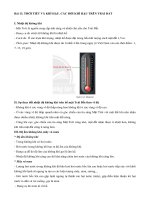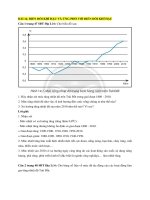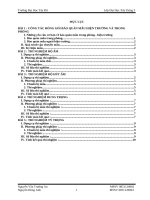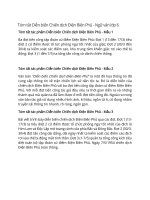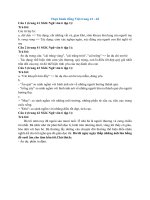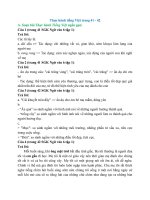14 pagealgorithms
Bạn đang xem bản rút gọn của tài liệu. Xem và tải ngay bản đầy đủ của tài liệu tại đây (736.12 KB, 31 trang )
Memory Management
Page Replacement Algorithms
Review
•
Memory Manager
–
–
–
•
coordinate how the different types of memory are used
keep track memory to allocate and release areas of main memory to processes
manage swapping between main memory and disk
No Memory Abstractions
–
Single program
•
•
•
–
One OS, only one process
Special register is used to protection between OS and process
Disadvantages: slow
Multiple program
•
•
•
One OS, many processes locate in memory
Divided into fixed size block
Disadvantages
–
–
Internal fragmentations
Two
programs
→ static relocation
both
reference
absolute
physical
memory
Review
•
Memory Abstractions
–
–
Multiple processes locate in memory (both primary and secondary)
Base and Limit Registers
•
•
Multiple processes locate in memory and protection
Base contains the first address of process in memory, Limit contains the length of process, the process owns private address
space
•
Disadvantages
–
–
–
External fragmentation (Defragment)
Slow
Swapping
•
•
•
Multiple processes with ready processes locate in memory and passive processes locate in HDD – swap file area
Swap out/ in operator
Disadvantages
–
–
External fragmentation
Process can not grow in memory and the swap area on the disk is full → data segment upward, stack segment
downward
Review
•
Memory Abstractions
–
Memory Management with Bitmaps
•
•
The memory divides units with same size that has a bit corresponding bit in the bitmap (0: free, 1: occupied)
Disadvantages
–
–
–
Internal fragment (large size)
Memory Management with Linked Lists
•
•
Maintain a linked list of allocated (P) and free memory (H)
Allocating algorithms
–
–
Slow when searching the bitmap to find a run of k consecutive 0 bits in the map (small)
First, Next, Best, Worst, Quick Fit
Virtual Memory
•
•
Software/ Process sizes larger than memory
Overlays
–
–
Developer splits program to many overlays
Disadvantages: developer‘s knowledge is important
Review
•
Memory Abstractions
–
Virtual Memory
•
Paging
–
–
–
–
Address space is broken up into pages
Physical memory is divided up into page frames
Virtual address vs. Physical address, manage address space with bit
MMU transfers Virtual address → p, d; then it looks up page table following the index to get the page frame; the page
frame combines with d to determine the physical address
–
–
Page fault: the program references a part of its address space that is not in physical memory
Page table
»
»
»
Load to collection registers, load to memory using base register, using TLB
Excessive large page table: multilevel page, inverted page table, inverted page table with hash or TLB
Entry: Caching disabled, Referenced, Modified, Protection, Present/absent, page frame number
Page replacement algorithms
Problems
•
At page fault and full physical memory
–
–
•
A currently loaded virtual page has to be evicted from memory
Choosing the page to be evicted
–
•
Space has to be made
Not a heavily used page reduce the number of page faults
Page replacement
–
–
The old page has to be written on the disk if it was modified
The new virtual page overwrite the old virtual page into the page frame
Page replacement algorithms
Optimal
•
Each page can be labeled with the number of instructions that will be executed before that page is
first reference
•
Choose the page that will be the latest one accessed in the future between all the pages actually in
memory
•
•
Very simple and efficient (optimal)
Impossible to be implemented in practice
–
•
It can be simulated
–
–
•
there is no way to know when each page will be referenced next
At first run collect information about pages references
At second run use results of the first run (but with the same input)
It is used to evaluate the performance of other, practically used, algorithms
Page replacement algorithms
Optimal
•
Ex:
–
–
–
–
a memory with free three frames
7
0 1
2 0 3
0 4
2 3
0
3
2 1 2 0 1 0 701
Number of page faults are 9 times
Number of page hits are 12 times
→ minimum of page fault is at least size of page frame that is allocated to process
→ principles: more and more page frame is allocated, less and less page fault occurs
Page replacement algorithms
Not Recently Used (NRU)
•
Each page has two status bits associated
–
–
•
Modified bit (M)
The two bits
–
–
–
•
Referenced bit (R)
updated by the hardware at each memory reference
once set to 1 remain so until they are reset by OS
can be also simulated in software when the mechanism is not supported by hardware
Algorithms
–
–
–
At process start the bits are set to 0
Periodically (on each clock interrupt) the R bit is cleared
For page replacement, pages are classified
•
•
•
•
•
•
Class 0: not referenced, not modified
Class 1: not referenced, modified
Class 2: referenced, not modified
Class 3: referenced, modified
The algorithm removes a page at random from the lowest numbered nonempty class
It is easy to understand, moderately efficient to implement, and gives an adequate performance
Page replacement algorithms
Not Recently Used (NRU) – Example
•
A computer has four page frames. The time of loading, time of last access, and the R and M bits for each page are as
shown below (the times are in clock ticks). Which page will be replaced?
Page
•
Loaded
Last Reference
R
M
0
226
280
0
0
1
160
265
0
1
2
110
270
1
0
3
120
285
1
1
The page 0 is replaced
Page replacement algorithms
First-In, First-Out (FIFO)
•
OS maintains a list of all pages currently in memory, with
–
–
•
•
•
the most recent arrival at the tail
the least recent arrival at the head
On a page fault, the page at the head is removed and the new page added to the tail of the list
It’s rarely used
Ex:
–
–
a memory with free three frames
7
0 1 2 0 3
0 4
2 3 0 3 2 1 2 010 7 0 1
Page replacement algorithms
•
•
Second-Chance
A modification of FIFO to avoid throwing out a heavily used page
Inspect the R bit of the oldest page
•
•
•
•
0 page is old and unused replaced
1 page is old but used its R bit = 0 and the page is moved at the end of the queue as a new arrived page
Look for an old page that has not been not referenced in the previous clock interval
If all the pages have been references FIFO
Tanenbaum, Fig. 3-15.
Page replacement algorithms
Second-Chance – Example
•
A computer has four page frames. The time of loading, time of last access, and the R and M bits for each page are as
shown below (the times are in clock ticks). Which page will be replaced?
Page
•
Loaded
Last Reference
R
M
0
226
280
0
0
1
160
265
0
1
2
110
270
1
0
3
120
285
1
1
The page 1 is replaced
Page replacement algorithms
Clock
•
In a second chance algorithms, it is unnecessarily inefficiency because it is constantly moving pages
around on its list
•
•
•
Keep all the page frames on a circular list in the form of a clock
The hand points to the oldest page
How to work
–
–
When a page fault occurs, the page being pointed to by the hand is inspected
If its R bit is 0, the page is evicted, the new page is inserted into the clock in its place, and the hand is advanced
one position
–
If R is 1, it is cleared and the hand is advanced to the next page
Page replacement algorithms
Clock
Tanenbaum, Fig. 3-16.
Page replacement algorithms
•
Least Recently Used (LRU)
Based on the observation that
–
•
•
Throw out the page that has been unused for the longest time when a page fault occurs
The algorithm keeps a linked list
–
–
–
•
the referenced page is moved at the front of the list
the page at the end of the list is replaced
the list must be updated at each memory reference costly
Implementing LRU with a hardware counter
–
–
–
–
•
pages that have been heavily used in the last few instructions will probably be heavily used again in the next few
keep a 64-bit counter which is incremented after each instruction
each page table entry has a field large enough to store the counter
the counter is stored in the page table entry for the page just referenced
the page with the lowest value of its counter field is replaced
Implementing LRU with a hardware bits matrix
–
–
N page frames N x N bits matrix
when virtual page k is referenced
•
•
–
bits of row k are set to 1
bits of column k are set to 0
the page with the lowest value is removed
Page replacement algorithms
Least Recently Used (LRU)
•
Ex:
–
–
–
–
a memory with free three frames
7
0 1
2 0 3
0 4 2
3 0 3 2 1 2
A memory with four page frames
0123210323
Tanenbaum, Fig. 3-17.
0 10 7 01
Page replacement algorithms
Least Recently Used (LRU) – Example
•
A computer has four page frames. The time of loading, time of last access, and the R and M bits for each page are as
shown below (the times are in clock ticks). Which page will be replaced?
Page
•
Loaded
Last Reference
R
M
0
226
280
0
0
1
160
265
0
1
2
110
270
1
0
3
120
285
1
1
The page 1 is replaced
Page replacement algorithms
Not Frequently Used (NFU)
•
•
•
A software implementation of LRU
A software counter associated with each page (initially 0)
At each clock tick the R bit is added to the counter for all the pages in memory; after that the R bits
are reset to 0
•
•
The page with the lowest counter is chosen when a page fault occurs
Problem:
–
–
The useful pages are evicted
The bit reference is useful to count the page to be reference, but it is not known the order of reference
Page replacement algorithms
Aging
•
•
A software implementation of LRU
modification of NFU
–
–
–
–
Shift right the counter one position
R bit is added to the leftmost bit
The page whose counter is the lowest is removed when a page fault occurs
Differences from LRU
•
•
does not know the page which was referenced first between two ticks; for example pages 3 and 5 at step (e)
the finite number of bits of counters → does not differentiate between pages with the value 0 of their counter
Page replacement algorithms
Aging
Tanenbaum, Fig. 3-18.
Page replacement algorithms
Thrashing
•
•
A program causing page faults every few instructions
A process is not allocated enough page frames as its requirements
→ Many processes are located in memory, thus, each process is allocated at least page frames
→ The page replacement takes more time (than execution)
→ The CPU utilization is decreased and some new process is loaded in the memory
•
The impact of thrashing on system
–
–
•
The system can be hanged
The process can not continually progress
Solution
–
–
Allocating enough page frame (!?) to the process
How to know the process need the number of page frame in progress
Page replacement algorithms
Locality of Reference
•
The process references only a relatively small fraction of its pages in execution
–
–
•
A small fraction is a set of pages that a process is currently using
The process moves from small fractions (that is needed in execution in time) to others
The process involves many small fractions that can intersected
Page replacement algorithms
Demand paging vs. Prepaging
•
Demand paging: Pages are loaded only on demand
–
–
•
Processes are started up with none of their pages in memory
CPU tries to fetch the first instruction → page fault
Prepaging
–
–
Loading the pages before letting processes run
Loading the pages before resuming the process
Page replacement algorithms
•
•
Working Set
The set of pages that a process is currently using
If the entire working set is in memory, the process will run without causing many faults until it
moves into another execution phase
•
•
Working set can changes over time
Problems
–
If the available memory is too small to hold the entire working set, the process will cause many page faults
and run slowly → thrashing
–
The process will just cause page faults until its working set has been loaded → slow, waste considerable
CPU time
•
Solutions
–
Using working set model
